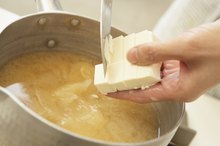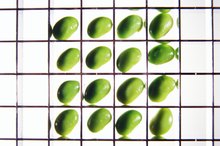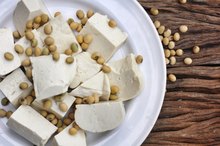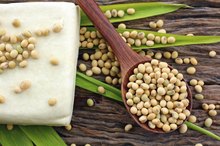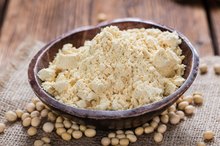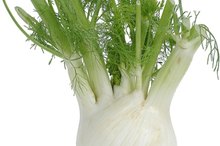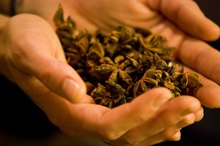What does fact checked mean?
At Healthfully, we strive to deliver objective content that is accurate and up-to-date. Our team periodically reviews articles in order to ensure content quality. The sources cited below consist of evidence from peer-reviewed journals, prominent medical organizations, academic associations, and government data.
- Mayo Clinic: Natural Breast Enhancement
- National Institutes of Health: Soy
- National Institutes of Health: Licorice
- Journal of Ethnopharmacology: Fennel and Anise as Estrogenic Agents
- Journal of Ethnopharmacology: Fennel and Anise as Estrogenic Agents
The information contained on this site is for informational purposes only, and should not be used as a substitute for the advice of a professional health care provider. Please check with the appropriate physician regarding health questions and concerns. Although we strive to deliver accurate and up-to-date information, no guarantee to that effect is made.
Ways to Naturally Stimulate Breast Growth
Many women desire larger, fuller breasts, but surgical breast enhancement techniques can be painful or prohibitively expensive 1. Fortunately, several natural techniques can increase breast size. Although these methods vary in their safety and effectiveness, they are all inexpensive and available without a prescription. Consult your health-care provider before using any home remedy to enhance your breast size. Note that, according to Mayo Clinic's Dr. Sandhya Pruthi, many breast-enhancing supplements can theoretically increase the risk of breast cancer 1.
Gain Weight
Human breasts are composed almost entirely of fat, and they tend to shrink after a woman experiences weight loss. If you are underweight, talk to your physician or dietitian about natural techniques for gaining weight. Eat a diet rich in healthy, high-calorie foods like olive oil, walnuts, peanuts and reduced-fat cheese. Weight gain will almost inevitably cause an increase in breast size.
- Human breasts are composed almost entirely of fat, and they tend to shrink after a woman experiences weight loss.
High-soy Diet
Benefits of Soy Protein for Breast Growth
Learn More
Soy is rich in estrogen-like compounds known as isoflavones, according to the U.S. National Institutes of Health 23. The NIH regards soy as a theoretical and unproven method for increasing breast size. In theory, minimally processed soy foods can cause an increase in levels of the breast-boosting hormone estrogen. Eat a diet rich in tofu, tempeh, edamame and soy milk to improve your breast size, but note that heavily processed soy "burgers" and "cheese" contain little of the plant's estrogen-boosting compounds.
- Soy is rich in estrogen-like compounds known as isoflavones, according to the U.S. National Institutes of Health 2.
- Eat a diet rich in tofu, tempeh, edamame and soy milk to improve your breast size, but note that heavily processed soy "burgers" and "cheese" contain little of the plant's estrogen-boosting compounds.
Herbal Supplements
Several herbal supplements are touted as natural breast enhancers, but Mayo Clinic's Pruthi questions the safety and effectiveness of these compounds 1. The National Institutes of Health states that licorice, one of the most popular herbal breast enlargers, contains compounds that elevate levels of the lactation-related hormones estrogen and prolactin 23. Red clover is a source of isoflavones similar to those found in soy, and blessed thistle has been used for centuries as a breast enlarger and lactation stimulant. Consult your health care provider before using any of these products, particularly if you have a medical condition or a family history of breast cancer.
Essential Oils
Can You Increase Breast Size With Diet?
Learn More
When applied directly to the skin, certain essential oils may help to stimulate breast growth. A study published in the Journal of Ethnopharmacology determined that fennel and anise oils share a potent estrogen-boosting compound known as anethole 4. Herbs containing anethole are traditionally brewed as a tea or taken internally to stimulate breast development in lactating mothers. Kelly Bonyata, a renowned lactation consultant, advises nursing mothers to stimulate lactation by applying diluted fennel oil directly to the breasts 5. Consider applying one or both oils to your chest daily, but consult your physician about the possible risks if you have a family history of breast cancer.
Related Articles
References
- Mayo Clinic: Natural Breast Enhancement
- National Institutes of Health: Soy
- National Institutes of Health: Licorice
- Journal of Ethnopharmacology: Fennel and Anise as Estrogenic Agents
- Kelly Bonyata: Fennel
- Alkabban FM, Ferguson T. Cancer, Breast. [Updated 2019 Jun 4]. In: StatPearls [Internet]. Treasure Island (FL): StatPearls Publishing; 2019 Jan-. Available from: https://www.ncbi.nlm.nih.gov/books/NBK482286/
- Powell RW. Breast Pain. In: Walker HK, Hall WD, Hurst JW, editors. Clinical Methods: The History, Physical, and Laboratory Examinations. 3rd edition. Boston: Butterworths; 1990. Chapter 169. Available from: https://www.ncbi.nlm.nih.gov/books/NBK277/
- Powell RW. Breast Examination. In: Walker HK, Hall WD, Hurst JW, editors. Clinical Methods: The History, Physical, and Laboratory Examinations. 3rd edition. Boston: Butterworths; 1990. Chapter 176. Available from: https://www.ncbi.nlm.nih.gov/books/NBK285/
- InformedHealth.org [Internet]. Cologne, Germany: Institute for Quality and Efficiency in Health Care (IQWiG); 2006-. Pain management in metastatic breast cancer. 2012 Feb 14 [Updated 2016 Apr 7]. Available from: https://www.ncbi.nlm.nih.gov/books/NBK361025/
- Cingam SR, Karanchi H. Cancer, Adrenal Metastasis. [Updated 2019 Jan 20]. In: StatPearls [Internet]. Treasure Island (FL): StatPearls Publishing; 2019 Jan-. Available from: https://www.ncbi.nlm.nih.gov/books/NBK441879/
- Khattab A, Monga DK. Cancer, Male Breast Cancer. [Updated 2019 Feb 14]. In: StatPearls [Internet]. Treasure Island (FL): StatPearls Publishing; 2019 Jan-. Available from: https://www.ncbi.nlm.nih.gov/books/NBK526036/
- Ajmal M, Van Fossen K. Breast Fibroadenoma. [Updated 2018 Dec 13]. In: StatPearls [Internet]. Treasure Island (FL): StatPearls Publishing; 2019 Jan-. Available from: https://www.ncbi.nlm.nih.gov/books/NBK535345/
- National Cancer Institute. Inflammatory Breast Cancer. Updated 01/06/16. https://www.cancer.gov/types/breast/ibc-fact-sheet
- Alkabban FM, Ferguson T. Cancer, Breast. [Updated 2019 Jun 4]. In: StatPearls [Internet]. Treasure Island (FL): StatPearls Publishing; 2019 Jan-.
- Powell RW. Breast Pain. In: Walker HK, Hall WD, Hurst JW, editors. Clinical Methods: The History, Physical, and Laboratory Examinations. 3rd edition. Boston: Butterworths; 1990. Chapter 169.
- National Breast Cancer Foundation. Breast Pain. nationalbreastcancer.org
- Koo MM, von Wagner C, Abel GA, McPhail S, Rubin GP, Lyratzopoulos G. Typical and atypical presenting symptoms of breast cancer and their associations with diagnostic intervals: Evidence from a national audit of cancer diagnosis. Cancer Epidemiol. 2017;48:140–146. doi:10.1016/j.canep.2017.04.010
- Smith RL, Pruthi S, Fitzpatrick LA. Evaluation and management of breast pain. Mayo Clin Proc. 2004;79(3):353-72.
- Morrow M. The evaluation of common breast problems. Am Fam Physician. 2000;61(8):2371-8, 2385.
- Powell RW. Breast Examination. In: Walker HK, Hall WD, Hurst JW, editors. Clinical Methods: The History, Physical, and Laboratory Examinations. 3rd edition. Boston: Butterworths; 1990. Chapter 176.
- Lee MD, Michelle, Owen MD, Wendi. My Breast Hurt. Should I be Worried? Society of Breast Imaging. sbi-online.org September 27, 2019
- Molckovsky A, Fitzgerald B, Freedman O, Heisey R, Clemons M. Approach to inflammatory breast cancer. Can Fam Physician. 2009;55(1):25–31.
- InformedHealth.org [Internet]. Cologne, Germany: Institute for Quality and Efficiency in Health Care (IQWiG); 2006-. Pain management in metastatic breast cancer. 2012 Feb 14 [Updated 2016 Apr 7].
- Rostami R, Mittal S, Rostami P, Tavassoli F, Jabbari B. Brain metastasis in breast cancer: a comprehensive literature review. J Neurooncol. 2016;127(3):407-14.
- Cingam SR, Karanchi H. Cancer, Adrenal Metastasis. [Updated 2019 Jan 20]. In: StatPearls [Internet]. Treasure Island (FL): StatPearls Publishing; 2019 Jan-.
- Sanguinetti A, Polistena A, Lucchini R, et al. Male breast cancer, clinical presentation, diagnosis and treatment: Twenty years of experience in our Breast Unit. Int J Surg Case Rep. 2016;20S(Suppl):8–11. doi:10.1016/j.ijscr.2016.02.004
- Khattab A, Monga DK. Cancer, Male Breast Cancer. [Updated 2019 Feb 14]. In: StatPearls [Internet]. Treasure Island (FL): StatPearls Publishing; 2019 Jan-.
- Yıldırım AC, Yıldız P, Yıldız M, Kahramanca Ş, Kargıcı H. Mastalgia-Cancer Relationship: A Prospective Study. J Breast Health. 2015;11(2):88–91. Published 2015 Apr 1. doi:10.5152/tjbh.2015.2492
- Ajmal M, Van Fossen K. Breast Fibroadenoma. [Updated 2018 Dec 13]. In: StatPearls [Internet]. Treasure Island (FL): StatPearls Publishing; 2019 Jan-.
- Crandall CJ, Aragaki AK, Cauley JA, et al. Breast tenderness and breast cancer risk in the estrogen plus progestin and estrogen-alone women's health initiative clinical trials. Breast Cancer Research and Treatment. 2012. 132(1):275-85. doi:10.1007/s10549-011-1848-9
- McCann B, MIaskowski C, Koetters T, et al. Associations between pro- and anti-inflammatory cytokine genes and breast pain in women prior to breast cancer surgery. The Journal of Pain. 2012. 13(5):425-37. doi:10.1016/j.jpain.2011.02.358
- National Cancer Institute. Inflammatory Breast Cancer. Updated 01/06/16.
Writer Bio
Juniper Russo, an eclectic autodidact, has been writing professionally since 2008. Her work has appeared in several online and print-based publications, including Animal Wellness. Russo regularly publishes health-related content and advocates an evidence-based, naturopathic approach to health care.
